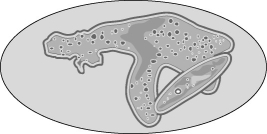Multiple Choice
You are given five test tubes, each containing an unknown protist, and your task is to read the following description and match these five protists to the correct test tube.
In test tube 1, you observe an organism feeding. Your sketch of the organism looks very similar to Figure 28.1. When light, especially red and blue light, is shone on the tubes, oxygen bubbles accumulate on the inside of test tubes 2 and 3. Chemical analysis of test tube 3 indicates the presence of substantial amounts of silica. Chemical analysis of test tube 2 indicates the presence of a chemical that is toxic to fish and humans. Microscopic analysis of organisms in test tubes 2, 4, and 5 reveals the presence of permanent, membrane-bounded sacs just under the plasma membrane. Microscopic analysis of organisms in test tube 4 reveals the presence of an apicoplast in each. Microscopic analysis of the contents in test tube 5 reveals the presence of one large nucleus and several small nuclei in each organism.

Figure 28.1
-Test tube 3 contains
A) Paramecium.
B) Navicula (diatom) .
C) Pfiesteria (dinoflagellate) .
D) Entamoeba.
E) Plasmodium.
Correct Answer:

Verified
Correct Answer:
Verified
Q40: If the Archaeplastidae are eventually designated a
Q41: A P. bursaria cell that has lost
Q42: You are given five test tubes, each
Q43: The next few questions refer to the
Q44: Paulinella chromatophora is one of the few
Q46: The next few questions refer to the
Q47: All protists are<br>A) unicellular.<br>B) eukaryotic.<br>C) symbionts.<br>D) monophyletic.<br>E)
Q48: Paulinella chromatophora is one of the few
Q49: Which of the following is characteristic of
Q50: The motility that permits P. bursaria to